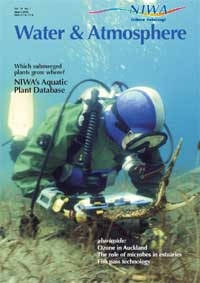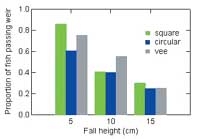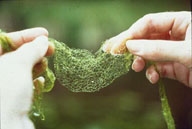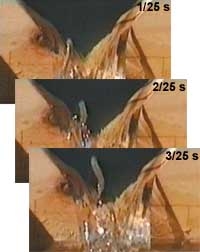PDF of this article (673 KB)

Cindy Baker Richard Allibone
Fish-pass design needs to take into account the abilities of the fish species likely to be using these structures to get past obstacles in rivers.

Proportion of inanga passing the weirs of different shapes with different vertical drops.

Proportion of inanga of different sizes found at the base of the weir and passing the weir for A 15-cm vertical drop and B 5-cm vertical drop. Data from all notch shapes are combined; for each vertical drop there were 50 fish per 90 min trial over 12 trials.

Fish attempting to pass the vee-notch weir with a 10-cm fall. above: Sequence of frames showing an inanga swimming over the weir; each frame 1/25 s. below: An unsuccessful attempt by an inanga to pass the weir by jumping from below.

Most New Zealanders are aware of the annual spring migration of swarms of tiny fish commonly known as whitebait. It is these migrations that prompt many a hopeful angler to sit with nets set on the margins of river mouths for hours at a time. The fish that do not end up on our dinner tables face the task of looking for freshwater habitat to grow and produce the offspring that may, next year, be part of our whitebait fritters.
During this upstream journey the whitebait must surmount any dams, culverts, weirs and other in-stream man-made structures that might block their passage. If the obstacles are unsurpassable, whitebait distributions could become restricted and this could ultimately lead to a decline in adult stocks.
Climbers and non-climbers
Many people are unaware that the whitebait catch contains five different species of fish. Some are good climbers and can scale the wetted margins of waterfalls, rapids and spillways. On the other hand, inanga – the main whitebait species – cannot climb and must swim past such obstacles. To do this, they swim in bursts to get past high-velocity areas and then rest in low-velocity areas. During floods or high flows, many obstacles become drowned allowing the passage of non-climbing fish. However, at low or moderate stream flows, swimming fish may be unable to get past. It is not uncommon to see fish such as inanga congregating in large numbers below obstacles. Here they are vulnerable to high mortality from predation, competition and disease.
Are some weirs easier to pass than others?
Teachers: this article can be used for Bio L8 A.O. 8.1. See other curriculum connections at www.niwa.co.nz/pubs/wa/resources
In a recent study, we looked at the effects of weirs of different shapes and heights on the upstream passage of inanga.
Three different weir shapes were evaluated: the vee-notch, square notch and circular notch. Each weir shape was tested with a vertical drop of 5, 10 and 15 cm and a constant flow rate of 3.5 l/s. For each trial 50 fish were given 90 minutes to pass the weir. Four trials were undertaken for each vertical drop and weir shape.
The shape of the weir did not affect the ability of inanga to pass (top graph, below). Instead, the vertical drop was the determining factor: as the vertical drop was increased, fewer inanga passed the weir.
The size of the fish did not significantly influence their ability to pass the weir (lower graph, below). As no size effect was found relative to vertical drop, this suggests that, given more time, more fish would eventually pass the weir at the greater heights.
Another factor affecting passage appeared to be motivation. We found that when fish were freshly caught and placed below the weir, only a few fish would swim past. After we held fish in live bins for 24 hours, their motivation increased. Thus, there was a marked increase in the number of fish passing the weir during the experimental period. One explanation could be reduced stress. In the later experiments, the fish had had a day to recover from the stress of catching, handling and transportation.
Inanga that successfully passed the weir did so by burst swimming – as shown right. Fish that jumped out of the water in an attempt to pass the weir were unsuccessful (right, bottom photograph).
We also checked the effect of changing flows on the ability of inanga to pass the weir. Using the square notch weir only (since notch shape was not a crucial factor) and a vertical drop of 10 cm, we found that doubling the flow resulted in significantly fewer fish passing the weir.
Our experiments showed that inanga are capable of passing a weir with a 15-cm vertical drop. However, these fish are hindered by increasing flow and increasing drop height. Thus, whitebait can’t jump but they sure can swim! This finding has implications for the construction of flow-monitoring weirs to ensure migratory fish passage. The results of experiments such as these can be used to determine the design of weirs in particular situations. An example is given in Successful fish passage past weirs.
Cindy Baker is based at NIWA in Hamilton; Richard Allibone was formerly with NIWA in Hamilton and is now with the Department of Conservation in Wellington.
